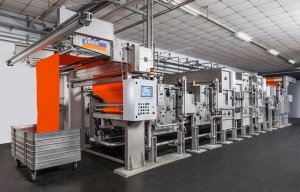
Benninger highlights sustainable textile production
The new technology is said to provide a higher level of flexibility making it advantageous for dyeing knitwear and stretch woven fabric.

26th November 2014
Knitting Industry
|
Uzwil
Benninger, the Swiss textile finishing and cord production machine ranges manufacturer, is offering its Küsters S-roller technology as a safe, reproducible dyeing method – the CPB (Cold Pad Batch) process. According to the company, the CPB process is becoming increasingly important, as it can be used to dye both short and long yardages of knitted and woven fabrics very economically.
The new Küsters S-roller technology with the very latest technical features combined with modern control equipment and electronics supplied by the Benninger mechanical engineering division is said to provide the technical process conditions that are expected of such a process today.
Dyeing is a very complex process and influenced by a number of parameters, the company reports and dyeing results are now not only gauged by visual assessment, but also by technical measuring instruments that can determine these results accurately and precisely.
According to the manufacturer, correction of dyeing faults is time-consuming and expensive and furthermore, ecological sustainability demands are constantly rising, especially with regards to the consumption of natural resources, and are increasingly becoming a cost factor that affects decisions. CPB dyeing with reactive dyes is a cost-effective process with a very high level of reproducibility, the company reports.
Impregnation in the padder is the most important part of CPB dyeing, Benninger reports. There are also other factors affecting the process that also require consideration but cannot be directly influenced by a plant engineer.
On the surface, the demand for an application system for forced application is relatively simple, Benninger observes and it must be ensured that the dye can be equally and constantly applied across the entire width of the fabric after a short period of contact with the dye liquor. This is only possible if the squeezing pressure and the squeezing nip can be kept constant, the company adds.

This task becomes complicated when the properties of the material to be dyed have to be included in calculations. From a purely technical viewpoint, conditions are affected by different fibre and yarn thicknesses, absorbency, fabric tension, weft distortion, admission moisture content and liquor temperature, dye properties and errors such as dye migration at the selvedges during drying. For this reason the requirements to be met by an application system are complicated and can only be satisfied by the use of state-of-the-art control and instrumentation equipment.
The new Küsters / Benninger S-roller technology is said to ensure even liquor application over the entire fabric width, as well as deliberately different liquor application in the edge-centre-edge areas. The reproducibility is maximised by an electronic pressure system (patented) that ensures controllable line forces over the entire roller width. In addition, dyers have a higher level of flexibility that is said to offer decisive advantages, especially when dyeing knitted fabrics and stretch woven fabrics.
Higher-level technologies that ensure additional process safety from a technical viewpoint, such as tailing correction and the cleverly designed dosing system with the track-proven Contidos, as well as the new four-circuit cooling and temperature management, enhance the ease of handling of the dyeing padder and its reproducibility, according to the company.
With computer aided simulation, the flow conditions at various speeds and with various fabric qualities were tested to prevent so-called dead zones in the dyeing trough, and resulted in the development of the mini U-Flow. It was therefore possible to improve additional influencing factors to achieve optimum dyeing results, which also has positive effects on the dye consumption, Benninger reports

Business intelligence for the fibre, textiles and apparel industries: technologies, innovations, markets, investments, trade policy, sourcing, strategy...
Find out more